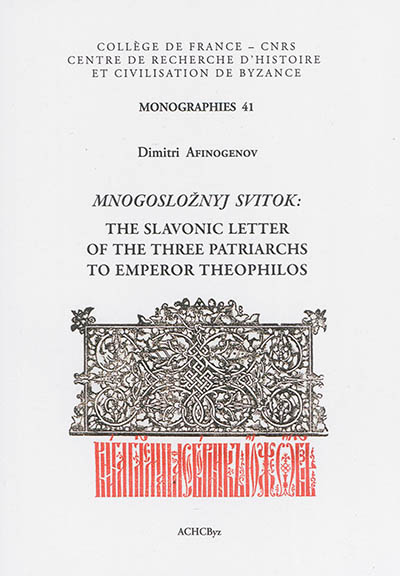en savoir plus

Permet à tous ses détenteurs d'obtenir 5% de réduction sur tous les livres lors du retrait en magasin (réduction non cumulable avec les réductions de type étudiant).
Offre également un certain nombre d'avantages auprès de nos partenaires.
Avec les favoris, retrouvez dans un espace les sélections effectuées au fur et à mesure de vos navigations dans le site.
Constituez pour votre usage personnel vos listes de livres en prévisions d'achats futurs et votre sélection d'articles, dossiers, événements, vidéos ou podcasts préférés ou à découvrir plus tard...
Il suffit simplement de cliquer sur "Ajout Favori" sur chaque page qui vous intéresse pour les retrouver ensuite dans votre espace personnel.
Requiert un compte Mollat
Requiert un compte Mollat
Mnogosloznyj svitok : the slavonic letter of the three patriarchs to emperor Theophilos
en savoir plus
Résumé
Traduction, analyse et critique de la version slavone de la lettre envoyée à l'empereur byzantin Théophile, en 836, par les trois patriarches Christophe d'Alexandrie, Job d'Antioche et Basile de Jérusalem. ©Electre 2025
Quatrième de couverture
One of the most mysterious texts from the Second Byzantine Iconoclasm (815-843) is the so-called Synodical Letter, purportedly sent by Patriarchs Christopher of Alexandria, Job of Antioch, and Basil of Jerusalem to Emperor Theophilos in 836. The earliest reference thereto is dated 945, whereas the oldest extant manuscript fragment is written in the ninth-century uncial. But was it a real missive or a pious forgery? Several Greek texts deriving from the lost original do not provide sufficient ground for a confident answer. Among the main problems is the lack of protocol elements indispensable for a document of this kind. Those elements, however, are present in the Slavonic text entitled Mnogosloznyj Svitok, which corresponds to (...) in Greek. A thorough scrutiny has revealed that this is the closest version we possess to the original Letter. The Slavonic, besides indications of place (Jerusalem) and date (836) within the main text, contains two solid termini ante quos, 837 and 838, and names the actual compiler of the Letter - a certain monk Basil, who can very well be identical with the hagiographer Basil of Emesa. The latter in his Life of Theodore of Edessa claims to have attended a synod in Jerusalem, presumably that of 836.
This book presents a critical edition of the Slavonic text together with corresponding Greek fragments, English translation, and Glossary. Russian translation is also attached.
Fiche Technique
Paru le : 01/01/2014
Thématique : Empire byzantin
Auteur(s) : Non précisé.
Éditeur(s) :
Association des amis du Centre d'histoire et de civilisation de Byzance
Collection(s) : Monographies
Contributeur(s) : Editeur scientifique (ou intellectuel) : Dimitri Afinogenov
Série(s) : Non précisé.
ISBN : 978-2-916716-47-3
EAN13 : 9782916716473
Reliure : Broché
Pages : 239
Hauteur: 24.0 cm / Largeur 18.0 cm
Poids: 0 g

